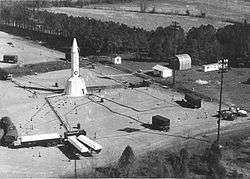PGM-19 Jupiter
| SM-78/PGM-19 Jupiter | |
|---|---|
|
Jupiter missile emplacement showing ground support equipment. The bottom third of the missile is encased in a "flower petal shelter" of wedge-shaped metal panels allowing crews to service the missile in all weather conditions. | |
| Type | Medium-range ballistic missile (MRBM) |
| Place of origin | United States |
| Service history | |
| Used by |
United States Air Force Italian Air Force Turkish Air Force |
| Production history | |
| Designed | 1954 |
| Manufacturer | Chrysler |
| Produced | 1956–1961 |
| Number built | ≈100 (45 deployed) |
| Variants | Juno II |
| Specifications | |
| Weight | 49,800 kg (110,000 lb) |
| Length | 18.3 m (60 ft) |
| Diameter | 2.67 m (8 ft 9 in) |
|
| |
| Propellant | kerosene and liquid oxygen |
Operational range | 1,500 mi (2,400 km) |
| Flight ceiling | 610 km (380 mi) |
The PGM-19 Jupiter was the first nuclear tipped, medium-range ballistic missile (MRBM) of the United States Air Force (USAF). It was a liquid-propellant rocket using RP-1 fuel and LOX oxidizer, with a single Rocketdyne LR70-NA (model S-3D) rocket engine producing 667 kN of thrust. It was armed with the 1.1 megaton W49 nuclear warhead. The prime contractor was the Chrysler Corporation.
The Jupiter was originally designed by the US Army, which was looking for a highly accurate missile designed to strike high-value targets like bridges, railway yards, troop concentrations and the like. The Navy also expressed an interest in the design as an SLBM, but left the collaboration to work on their Polaris. Jupiter retained the short, squat shape intended to fit in naval submarines.
The U.S. Army set accuracy goals so high that some expressed skepticism they could be met, but the Redstone team successfully designed a system with a circular error probable (CEP) of 0.5 miles (0.80 km), substantially more accurate than similar designs like the US Air Force's Thor. A presidential report suggested this made it the most valuable missile then being developed. This led to continual inter-service fighting between the Army and Air Force, and ultimately to Charles Erwin Wilson's decision to give the Jupiter missiles to the U.S. Air Force.
The Air Force was never greatly interested in supporting Jupiter; they saw no need for its accuracy in their battle plans and had their own Thor with longer range. Production went ahead and the nuclear tipped missiles were deployed in both Italy and Turkey in 1961 due to NATO's Cold War deterrence against the Soviet Union. All were then later removed by the United States as part of a secret agreement (The Secret Deal) with the Soviet Union during the Cuban Missile Crisis. They were considered to be outdated. It was also used as the basis for a satellite launcher known as Juno II, but had a short and unsuccessful career in this role. It is unclear as to what happened to the missiles in Italy, but they too were removed at some point.
Development history
Redstone
In the aftermath of World War II, a number of German rocket scientists and engineers were moved to the United States as part of Operation Paperclip. Rocketry was at that time considered to be a sort of long-range artillery, and naturally fell to the Army to explore. The group was settled at Fort Bliss, Texas - where they aided General Electric's Project Hermes efforts to build and test a variety of V-2-derived designs at the nearby White Sands Proving Ground.[1]
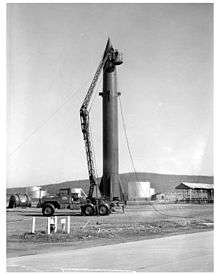
Around the same time, North American Aviation (NAA) won the contract to build a long-range cruise missile that became the SM-64 Navaho. This used ramjet power and needed to be boosted up to operational speed by some sort of rocket. Their Propulsion Division was given two V-2 engines to work with to meet this requirement, along with a wealth of research papers from the original V-2 engine team. The NAA team discovered that a major upgrade to the V-2's original Model 39 engine was planned through the use of a new fuel injector design, but the Germans were not able to cure lingering combustion problems. Setting themselves to this task, NAA successfully solved the problems and began using this new injector. This became the XLR-41 Phase III engine, which provided 75,000 pounds-force (330,000 N) of thrust, a third greater than the Model 39, and was also somewhat lighter and smaller than the German design.[2]
The outbreak of the Korean War in June 1950 led to calls for the rapid deployment of new missiles, and the Army responded by developing a requirement for a ballistic missile with 500 miles (800 km) range while carrying a 500 pounds (230 kg) warhead that could be operational as rapidly as possible. The fastest solution was to provide the German team with anything they needed to achieve this goal by adapting the V-2 design. The team, under the leadership of Wernher von Braun, began work on the problem while at Fort Bliss, but in 1951 they moved to the Redstone Arsenal in Huntsville, Alabama, home to the Army's Ordnance commands. Initially known as the Ordnance Guided Missile Center, then the Guided Missile Development Division (GMDD), in 1956 they finally became the Army Ballistic Missile Agency, or ABMA.
Taking the XLR-41, renamed as the NA-75-110 in Army use, they wrapped it in the largest airframe it could lift, thereby increasing fuel load and extending the range. The result was essentially a larger version of the V-2. As tensions of the Cold War mounted, the Army changed the requirement to be able to carry smallest nuclear warheads in the inventory - with a warhead weight of 6,900 pounds (3,100 kg), range was reduced to only 175 miles (282 km). Design work was complete in 1952 and on 8 April it became known as the SSM-G-14 Redstone (Surface-to-Surface Missile, G for Army). The first ABMA-built prototype flew in August 1953, the first production-line model from Chrysler in July 1956, and the Redstone entered service in 1958.
Initial concept
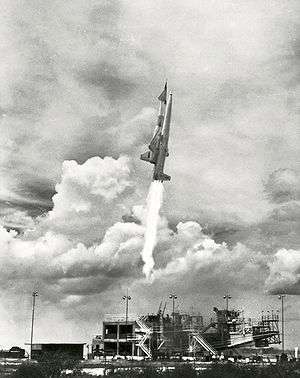
While the "Redstone" program continued, NAA was receiving a continual stream of orders from the Air Force to extend the range and payload of their Navaho design. This required a much larger missile, and a much larger booster to launch it. As a result, NAA was continually introducing new versions of their engines. By the mid-1950s, NAA had a version known as the XLR-43 running at 120,000 pounds-force (530,000 N) thrust, while further reducing weight at the same time. Much of this was due to the introduction of the tubular wall combustion chamber, which was much lighter than the cast-steel designs of the V-2, while also offering much better cooling which allowed the combustion rate, and thus thrust, to be increased.[2]
While the Navajo program dragged on, NAA split the team into three groups, Rocketdyne handled engines, Autonetics developed inertial navigation systems (INS) and the Missile Division retained the Navaho itself. With this breakup of duties, both Rocketdyne and Autonetics were soon asked to provide solutions for other projects. In particular, the Air Force asked Rocketdyne to provide an engine for their SM-65 Atlas which they did by adapting the XLR-43 to run on JP-4 instead of alcohol, becoming the LR89. In addition to the switch to JP-4, the engine did away with the hydrogen peroxide system of the XLR-41 that powered the turbopumps and replaced it with a turbine that ran on the rocket fuel itself, simplifying the overall design.[2]
Von Braun's team initially considered making a version of the Redstone using the LR89 and adding a second stage, stretching the range to 1,000 nautical miles (1,900 km; 1,200 mi).[3] But ongoing work on the LR89 suggested that the engine could be further improved, and in 1954, the Army approached Rocketdyne to provide a similar design with a thrust of 135,000 pounds-force (600,000 N).[2] Over this period the weight of nuclear warheads was rapidly falling, and by combining this engine with a warhead of 2,000 pounds (910 kg) they could build a single-stage missile able to reach 1,500 nautical miles (2,800 km; 1,700 mi) while being significantly less complicated and easier to handle in the field than a two-stage model. This engine was continually upgraded, ultimately reaching 150,000 pounds-force (670,000 N).[3] This last model, known to the Army as the NAA-150-200, became much better known by its Rocketdyne model number, S-3.[4]
IRBM battles
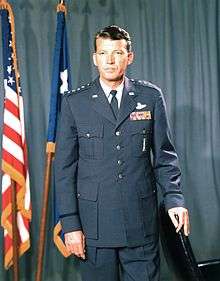
In January 1955, the Air Force's Scientific Advisory Group (SAG) urged the Air Force to develop a MRBM. They felt that it was far less technically risky than the SM-65 Atlas ICBM the Air Force was developing, and would enter service earlier. General Bernard Adolph Schriever, leader of the Air Force's Western Development Division in charge of Atlas development, was opposed to the concept, feeling that it would divert resources from the Atlas efforts.[5]
In February, the United Kingdom expressed an interest in obtaining an intermediate range ballistic missile (IRBM) that could strike the Soviet Union from bases within the UK. This added impetus to desires for a MRBM, but this ran afoul of ongoing concerns about the sharing of nuclear information.[5] Later that same month, the initial report of the Killian Committee was published. Among its many recommendations was the statement that the US should build an IRBM as soon as possible. They based their argument on the fact that an IRBM could strike any point in Europe from any point in Europe. This would be so valuable to the Soviets that they surely develop such a system, so the US should build one first.[5]
In March 1955, the Army approached the Air Force about their MRBM design. When the Air Force had split from the Army in 1947, the two forces had a tacit agreement that the Army would be responsible for designs flying less than 1,000 miles (1,600 km), while the Air Force took over those with greater range. The new design's 1,500 mile range placed it within the umbrella of the Air Force, so the Army offered to design and build the missile for operation by the Air Force. In spite of addressing the calls for an Air Force M/IRBM, and that taking it over would keep the Army out of the long-range missile game, General Schriever dismissed the idea outright:
| “ | It would be naive to think that the Army would develop a weapon and then turn it over to the Air Force of operate. Therefore, I strongly recommend that our relationship with Redstone [Arsenal] remain on an exchange of information basis.[6] | ” |
As the calls for an IRBM continued, Schriever finally acquiesced and suggested that an IRBM could be created out of a down-scaled Atlas, thereby avoiding any duplication of effort. Contract tenders for such designs were sent out in May 1955. However, by July the Joint Coordinating Committee on Ballistic Missiles concluded that there were enough differences between the two concepts that an entirely new design should be built for the role.[5]
The Army, meanwhile, did not give up on their design. In September 1955, von Braun briefed the U.S. Secretary of Defense and the Armed Services Policy Council on long range missiles, pointing out that a 1,500 mi (2,400 km) missile was a logical extension of the Redstone. He proposed a six-year development program costing $240 million (equivalent to $2.12 billion in 2015) with a total production of 50 prototype missiles.[3]
Navy interest
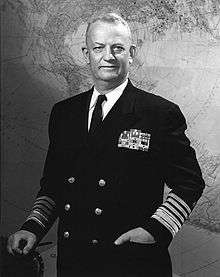
Around the same time, the US Navy was looking for ways to join the nuclear club, and had been focusing mostly on cruise missiles and similar systems. Some consideration had been given to the use of ballistic missiles on ships, but Admiral Hyman Rickover, "father" of the nuclear submarine, was skeptical that this could be done, and was worried it would take up funding needed elsewhere.[7]
Lower-ranking Navy officials became increasingly interested when the Army and Air Force began serious development of their long-range missiles. In an attempt to bypass high-ranking Navy officials, who remained uninterested in the concept, the Navy liaison to the Killian Committee championed the cause. The Committee took up the concept, and in September 1955 released a report calling for the development of a sea-based missile system.[8]
The Navy's disinterest in missiles had been greatly reduced with the August 1955 appointment of Admiral Arleigh Burke to the Chief of Naval Operations, replacing Robert B. Carney, the primary opponent of missile development. Burke was convinced the Navy had to get into the missile field as rapidly as possible, and was well aware that the Air Force would oppose any such endeavor. Instead, he approached the Army, and found their new design to fit the range goals needed by the Navy.[8]
Development begins
The issue of who would be given the go ahead to build an IRBM by this time had reached the Joint Chiefs of Staff (JCS), who proved unable to reach a decision. This forced the Secretary of Defense Charles Erwin Wilson to move ahead without an official recommendation from the military. He saw the Navy interest as a reasonable argument to continue the Army project in any event, and on 8 November 1955 approved both programs. The Air Force would develop IRBM #1, or SM-75 (for "strategic missile"), the Army would develop their design as IRBM #2 or SM-78. The Navy would develop systems to launch the Army missile from ships, and later, submarines.[8][5]
The requirement for shipboard storage and launching dictated the size and shape of the Jupiter. The original Army design was 92 feet (28 m) long and 95 inches (2,400 mm) in diameter. The Navy stated they were not interested in anything longer than 50 feet (15 m). The ABMA team responded by increasing the diameter to 105 inches (2,700 mm). This precluded it from being carried aboard contemporary cargo aircraft, limiting it to sea and road. Even with this change they were unable to reduce its length enough to suit the Navy. They suggested that they begin with a 60 foot (18 m) long version and then scale it down as improvements in the engines were worked into the design. This was rejected, and after briefly considering a 55 foot (17 m) version, finally settled on the 58 foot (18 m) version.[9]
On 2 December 1955, the secretaries of the Army and Navy publicly announced the dual Army–Navy program to create a land- and sea-based MRBM. In April 1956, as part of a widespread effort to assign names to various missile projects, the Army's effort was given the name "Jupiter" and the Air Force's became "Thor".[3]
Navy exit

The Navy was concerned from the start about Jupiter's cryogenic propellants, but at the time there was no other option. Given the size and weight of contemporary nuclear weapons, only a large liquid fuel rocket engine provided the energy needed to meet the Navy's range goal of launching from safe areas in the Atlantic Ocean. They justified the risk thus:
| “ | We were prepared to take the chance that we might lose a submarine or two through accidental explosions. But, then, there are some of us who enjoy, or at lease [sic] are acclimated to, the idea of risking our lives."[10] | ” |
All of this changed radically in the summer of 1956, when Project Nobska brought together leading scientists to consider antisubmarine warfare. As part of this workshop, Edward Teller stated that by 1963 a 1 megaton warhead would be reduced to only 600 pounds (270 kg).[11] Rocketry experts at the same meeting suggested that an intermediate-range weapon carrying one of these weapons could be built using solid propellant. Even in this case the missile would be much smaller than Jupiter; Jupiter was expected to weigh 160,000 pounds (73,000 kg), while estimates of a solid fuel missile with similar range were closer to 30,000 pounds (14,000 kg), along with a similar reduction in size which was of paramount importance to a submarine design.[12]
The Navy announced their desire to develop their own missile that summer, initially under the name Jupiter-S. After intensive follow-up studies, the Navy withdrew from the Jupiter program in December 1956. This was officially announced by the Army in January 1957.[13] In its place, the Navy began development of what was then known as the Fleet Ballistic Missile Program, and the missile was later renamed Polaris, their first submarine-launched ballistic missile (SLBM). Rickover, one of the few remaining skeptics, was won over by pointing out that a properly designed submarine was needed specifically for this role, and he would be called upon to produce it. Rickover was from that point on a staunch ally of the program.[14]
Jupiter vs. Thor
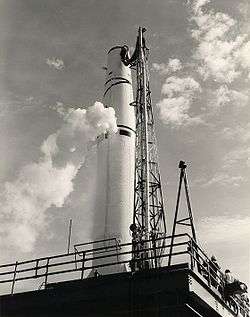
ABMA's work on the Jupiter progressed throughout the Navy's brief involvement, especially work on the INS. The goal had originally been to match Redstone's accuracy at the Jupiter's much extended range, but as development continued it became clear the ABMA team could improve on that considerably. This led to a period in which "The Army would lay down a particular accuracy, and wait for our arguments whether it was possible. We had to promise a lot, but were fortunate."[15]
This process ultimately delivered a design intended to provide 0.5 miles (0.80 km) accuracy at the full range, a radius one fourth that of the best INS designs being used by the Air Force. The system was so accurate that a number of observers expressed their skepticism about the Army's goals, with the WSEG suggesting they were hopelessly optimistic.[15]
The Army's desire for accuracy was a side-effect of their mission concept for nuclear weapons. They saw the weapons as part of a large-scale battle in Europe, in which both sides would use nuclear weapons during a limited war that did not include the use of strategic weapons on each other's cities. In that case, "if wars were to be kept limited, such weapons would have to be capable of hitting only tactical targets." This approach saw support of a number of influential theorists, notably Henry Kissinger, and was seized on as a uniquely Army mission.[16]
Although the Air Force had started their own IRBM to compete with Jupiter, development was lackadaisical. They had the much more impressive Atlas to worry about, and even that saw relatively little interest in a force dominated by Strategic Air Command's bomber-centric strategic vision.[17] Curtis LeMay, leader of SAC, was generally uninterested in Atlas, considering it useful only as a way to blast holes in the Soviet defensive systems to let his bombers through.[18] But as the Jupiter program began to progress they became increasingly concerned that it would enter service before Atlas, potentially handing the Army some sort of strategic role in the short term.
The Air Force vision of war was significantly different from the Army's, consisting of a massive attack on the Soviet Union in the event of any sort of major military action, the so-called "Sunday punch."[19][lower-alpha 1] The possibility of a major war that did not escalate to the point where strategic weapons were used was a serious concern to Air Force planners. If the Soviets became convinced the US would respond to tactical nuclear use in kind, and that such use would not automatically unleash SAC, they might be more willing to chance a war in Europe where they might maintain superiority.
The Air Force began to agitate against Jupiter, saying that the Army's vision of a low-scale nuclear war was destabilizing, while claiming that their own Thor missile did not represent this sort of destabilizing force as it was purely strategic. They may also have been motivated by the WSEG's comments that if the Jupiter team's accuracy claims were true, "they would indicate that Jupiter is the most promising weapon for development."[20]
Army to Air Force
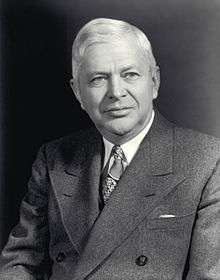
As the Air Force's arguments against Jupiter grew more vocal, the argument came to encompass several other ongoing projects that the two forces had in common, including surface-to-air missiles and anti-ballistic missiles. By the middle of 1956, both forces were engaged in tit-for-tat attacks in the press, with the Air Force calling the Army "unfit to guard the nation" on the front page of The New York Times and sending out press releases about how bad their SAM-A-25 Nike Hercules missile was compared to the Air Force's IM-99 Bomarc.[21]
Sick of the internecine fighting, Secretary of Defense Wilson decided to end it once and for all. Examining a wide variety of complaints between the two forces, on 18 November 1956 he published a memo that limited the Army to weapons with 200 miles (320 km) or less, and those dedicated to air defense to half that.[22] Jupiter's 1,500 mile range was well over this limit, but instead of forcing them to cancel the project, Wilson had the ABMA team continue development and the Air Force to ultimately deploy it.[23] This was precisely the plan that Schriever had rejected the year before.
The Army was apoplectic, and let the press know it.[24] This ultimately led to the court-martial of Colonel John C. Nickerson Jr., after he leaked information about various Army projects, including the then-secret Pershing missile.[25][26]
The Air Force was no happier, as they had little real interest in anything other than Atlas, and didn't see a strong need for one IRBM, let alone two.[19] Through 1957 the situation between the Air Force and ABMA was almost nonfunctional, with ABMA requests for updates on the project going unanswered for months. The Air Force did, however, reduce the production rate from two missiles per month to one. They then began a review process with the thinly disguised goal of canceling Jupiter.[27]
Saved from cancellation
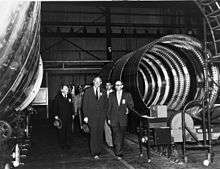
On 8 October 1957, the Soviets successfully launched Sputnik I from their R-7 Semyorka ICBM. The US was aware of these efforts and had already talked to the press about it, suggesting that if the Soviets launched a satellite first it would be no big deal.[28] To their surprise, the press exploded in rage over the affair. Having spent over a decade working on similar missiles, like Atlas, that the Soviets could beat them was a serious blow, and prompted a deep review of the ongoing programs.[29]
One problem noted from the start was that the internecine fighting between the Army and Air Force was leading to significant duplication of effort, with little to show for it. The Department of Defense responded by creating the Advanced Research Projects Agency (ARPA), whose initial mission was to look over all of the ongoing projects and select ones based solely on their technical merits. Jupiter was clearly a good system, and any Air Force thoughts about canceling it were immediately quashed.[27]
New orders for 32 prototypes and 62 operational missiles were soon placed, bringing the total number of Jupiters to be built to 94. The first, hand built at ABMA, would be delivered by the end of FY57, and the first production models from Chrysler's Michigan Ordnance Missile Plant near Warren, Michigan between FY58 and FY61.[27]
Lingering complaints
A primary complaint about Jupiter was that the design's shorter range placed it within relatively easy striking distance of Soviet weapons, both missiles and aircraft. Thor, based in the UK, would likely have more warning of an impending attack.[lower-alpha 2] This is precisely the reason that the Army spent considerable effort on making Jupiter mobile, in order to make surprise attacks difficult without prior aerial reconnaissance missions.[15]
However, in November 1958, the Air Force decided Jupiter would be launched from fixed emplacements. Army General Maxwell Taylor argued this was done deliberately, noting that:
| “ | ...a mobile missile needs Army-type troops to move, emplace, protect and fire it... a decision to organize mobile ballistic missile units would in logic have led to transferring the operational use of the weapon back to the Army - where it should have been all the time.[15] | ” |
To offset the possibility of air attack, the systems were upgraded to allow a launch within 15 minutes of a launch order.[27]
Army to NASA

With the Army stripped of their long-range surface-to-surface role, the question arose as to what to do with the ABMA team. The large team built up for the Redstone and Jupiter efforts would not be needed for the short range missiles fitting the Wilson range limits, but breaking up the team was something no one wanted.[30]
The team soon began working on non-military rockets, which did not fall under the Wilson range requirements. This led to a series of designs extending the existing Juno series, using various combinations of parts from Army and Air Force missiles to meet a wide variety of performance goals. During a visit by ARPA, the various plans were presented, notably the Juno V concept which ABMA saw as a solution for launching the spy satellites the Air Force was designing. The Air Force was, unsurprisingly, planning to use its own launcher for this, an expanded version of the upcoming Titan II. ARPA then provided ABMA with initial funding to keep the Juno V project moving, and assigned it von Braun's preferred name of "Saturn", meaning "the one after Jupiter".[30]
Meanwhile, Eisenhower was interested in handing the job of space exploration to a civilian body, which would avoid any potential issues over the militarization of space. This was formed as NASA in late 1958.[31] This provided a solution of what to do with ABMA, which was handed over to NASA to become the Marshall Space Flight Center. When Kennedy announced the goal of landing on the Moon on 25 May 1961, two competing designs were considered for the booster, Marshall's Saturn V, and one designed by a NASA in-house team, Nova. The selection of Saturn led to the success of the Apollo project.[32]
Testing
Engines
Rocketdyne tested its first S-3 engine at their Santa Susana, California facilities in November 1955. A mock-up was delivered to ABMA in January 1956, and followed with the first prototype engines in July 1956.Testing of these engines began in September 1956 at ABMA's new Power Plant Test Stand. This demonstrated a number of problems with unstable combustion, leading to the failure of four engines by November. To continue testing, the engine was temporarily derated back to 135,000 lbf, and they were successfully tested at this level in January 1957. Continued work on the engine developed several sub-versions, finally reaching the design goal of 150,000 lbf in the S-3D model. [33]
Jupiter-A
To test various parts of the Jupiter equipment, ABMA began launching Jupiter hardware on previously planned Redstone development missions. These were known under the name Jupiter-A. Among the systems tested by Jupiter-A were the ST-80 INS, angle-of-attack sensors, fusing systems and the explosive bolts that separated the booster from the upper stage.[34]
ABMA and the Air Force disagree on how many flights were part of the Jupiter-A series. ABMA lists Redstone RS-11 as the first Jupiter-A launch on 22 September 1955. with RS-12 following on 5 December. This means these flights took place before the Jupiter program was even official. The Air Force states the first was on 14 March 1956. Likewise the Air Force does not claim the last three Redstone flights, RS-46, CC-43 and CC-48, to be part of the Jupiter-A program, while ABMA lists them.[34]
In total, ABMA lists 25 launches as part of the Jupiter-A series, every Redstone launched between September 1955 and 11 June 1958. The Air Force lists only the 20 in the middle of this period.[34]
Jupiter-C
While development of the missile was underway, design of the reentry vehicle was progressing rapidly. In order to gain test data on the design before the missile would be ready to launch it, ABMA designed the Jupiter-C, short for "Jupiter Composite Test Vehicle". This was not really a Jupiter at all, but a Redstone with an 8 foot (2.4 m) stretch to hold more fuel, topped with two upper stages consisting of clusters of small solid fuel rockets, topped by a subscale version of the Jupiter reentry vehicle.[35]
The bare Jupiter-C flew for the first time on 20 September 1956, flying further and faster than any previous rocket. The complete system with a dummy reentry vehicle flew twice in 1957, the first on 15 May and the second on 8 August. The second of these tests also used a new three-stage upper that had been designed for the Juno I rocket, a further expansion of the Jupiter-C intended for future space launches. It was a Juno I that launched the US's first satellite, Explorer I, on 31 January 1958.[35]
Static tests
In 1954 Test Laboratory director Karl Heimburg began construction of the Static Test Stand for Redstone testing. This was still under construction when it was re-purposed for Jupiter, and finally competed in January 1957.[36] A Jupiter was installed in the stand that month, and fired for the first time on 12 February 1957. This almost ended in disaster when a small explosion went off in the liquid oxygen (LOX) pump, and as the missile sat there the LOX boiled off and threatened to burst the tanks. The day was saved when the foreman, Paul Kennedy, ran to the missile and connected a pressure line to drain the oxygen buildup in the tank. The problem was later traced to the lubricant used in the pump, which tended to burst into flames in contact with LOX. A new lubricant was introduced, along with a series of changes to the test stand to help retain control in these situations.[37]
Flight tests
Kurt Debus had led the construction of launch pads for Redstone missiles at Cape Canaveral, Florida, building the twin LC-5 and LC-6 pads about 500 feet (150 m) apart with a common blockhouse located 300 feet (91 m) away between the two. Redstone testing moved to these pads from the smaller LC-4 on 20 April 1955, with the launch of the seventh Redstone from LC-6. Envisioning an extended test program, a second set of similar pads began construction in 1956, LC-26 A and B; the only major difference was the blockhouse was located slightly further away, about 400 feet (120 m). In late 1957 a set of parallel railway tracks running just east of the pads was added, allowing an A-frame gantry to be rolled to any of the four pads.[38]
Jupiters were delivered to the Cape strapped to wheeled trailers and flown to the Cape's "Skid Strip" on C-124s. They were then moved to Hangar R at the Cape Industrial Area where the nose cone was mated with the missile, and electrical checkout was performed. It was then moved on the trailer to the pads, about 3.5 miles (5.6 km) south, where they were lifted to vertical by a crane on the movable gantry. Just to the north of the launch area was the Air Force's LC-17 for Thor, and LC-18 used for Thor and the Navy's Vanguard. After the Army's head start, the Air Force had since caught up and attempted its first Thor launch on 26 January 1957, which ended with the missile exploding on the launch pad.[39]
Jupiter test flights officially commenced with the launch of AM-1A (ABMA Missile 1A) on 1 March 1957 from LC-5. This missile was equipped with the lower-thrust interim engine. The vehicle performed well until past 50 seconds into launch when control started to fail, leading to breakup at T+73 seconds. It was deduced that turbopump exhaust was sucked up by the partial vacuum in the area behind the missile and began to burn in the tail section. The heat burned though the control wiring, so extra insulation was added there on future flights. An identical AM-1B was quickly readied and launched on 26 April. AM-1B broke apart at T+93 seconds from propellant slosh, leading to the addition of baffles to the fuel tanks.[39]
The third Jupiter, also numbered AM-1, successfully flew from LC-5 on 31 May, traveling a full 1,247 nautical miles (2,309 km; 1,435 mi) downrange. This version had a slightly improved S-3 engine with 139,000 pounds-force (620,000 N) thrust. AM-2 flew from LC-26A on 28 August, and successfully tested the separation of the rocket body from the reentry vehicle section before splashing down at 1,460 nautical miles (2,700 km; 1,680 mi). AM-3 flew from LC-26B on 23 October, including the ablative heat shield and the new ST-90 INS. This test flew a planned distance of 1,100 nautical miles (2,000 km; 1,300 mi).[39]
Turbopump problems caused AM-3A to explode at T+101 seconds on 26 November, and AM-4 to lose power at T+117 seconds on 18 December and fall into the ocean 149 nautical miles (276 km; 171 mi) downrange. These were traced to an inadequate design that resulted in a string of failures in the Jupiter, Thor, and Atlas programs, all of which used a variant of the same Rocketdyne engine. Testing then paused for five months while Rocketdyne came up with a number of fixes and the Army retrofitted all its Jupiters with the redesigned pumps.[39] In spite of these failures, Jupiter was declared operational on 15 January 1958.
Taking the time to also fully rate the engine to 150,000 lbf, the new engine was first flown on AM-5 on 18 May 1958 from LC-26B, reaching a planned 1,247 nautical miles (2,309 km; 1,435 mi). AM-5 also carried the real nose cone design, which separated from the rocket body, spun up the warhead, and separated to allow the warhead to continue on its own. The warhead section was equipped with a parachute and was recovered by the Navy some 28 nautical miles (52 km; 32 mi) from its predicted splashdown point.[39]
AM-6B included both the production nose cone and the ST-90 INS during its launch from LC-26B on 17 July 1958. This time the Navy recovered it only 1.5 nautical miles (2.8 km; 1.7 mi) from its planned splash down point 1,241 nautical miles (2,298 km; 1,428 mi) downrange. AM-7 flew 1,207 nautical miles (2,235 km; 1,389 mi) on 27 August, testing a new solid fuel rocket for spinup, replacing the older hydrogen peroxide model. AM-9 was launched on 10 October, the first Jupiter to carry the fully functional turbine exhaust roll control system. The flight failed however; a pinhole leak caused a fire in the thrust section and loss of control, leading to a Range Safety destruct 49 seconds into the launch.[39]
Afterwards, there was only one more failure in the Jupiter program, AM-23 on 15 September 1959, which developed a leak in a helium bottle that led to depressurization of the RP-1 tank and almost immediate loss of control at liftoff. The missile wobbled from side-to-side until finally pitching over, followed by the RP-1 tank breaking in half and dumping its contents before Range Safety sent the destruct command. Flying debris struck and damaged a Juno II on the adjacent LC-5. This particular launch was carrying a biological nose cone with mice and other specimens (which did not survive).[40]
Through the early 1960s, a number of Jupiters were launched by the forces of other countries, as well as the Air Force, as part of ongoing combat training. The last launch of this sort was by the Italian Air Force, CM-106, which took place from LC-26B on 23 January 1963.[41]
Biological flights

Jupiter missiles were used in a series of suborbital biological test fights. On 13 December 1958, Jupiter AM-13 was launched from Cape Canaveral, Florida with a Navy-trained South American squirrel monkey named Gordo on board. The nose cone recovery parachute failed to operate and Gordo did not survive the flight. Telemetry data sent back during the flight showed that the monkey survived the 10 g (100 m/s²) of launch, eight minutes of weightlessness and 40 g (390 m/s²) of reentry at 10,000 mph (4.5 km/s). The nose cone sank 1,302 nautical miles (2,411 km) downrange from Cape Canaveral and was not recovered.
Another biological flight was launched on 28 May 1959. Aboard Jupiter AM-18 were a seven-pound (3.2 kg) American-born rhesus monkey, Able, and an 11-ounce (310 g) South American squirrel monkey, Baker. The monkeys rode in the nose cone of the missile to an altitude of 59 miles (95 km) and a distance of 1,500 miles (2,400 km) down the Atlantic Missile Range from Cape Canaveral. They withstood accelerations of 38 g and were weightless for about nine minutes. A top speed of 10,000 mph (4.5 km/s) was reached during their 16-minute flight.
After splashdown the Jupiter nosecone carrying Able and Baker was recovered by the seagoing tug USS Kiowa (ATF-72). The monkeys survived the flight in good condition. Able died four days after the flight from a reaction to anesthesia while undergoing surgery to remove an infected medical electrode. Baker lived for many years after the flight, finally succumbing to kidney failure on 29 November 1984 at the United States Space and Rocket Center in Huntsville, Alabama.
Operational deployment
In April 1958, the U.S. Department of Defense notified the Air Force it had tentatively planned to deploy the first three Jupiter squadrons (45 missiles) in France. However, in June 1958 the new French President Charles De Gaulle refused to accept basing any Jupiter missiles in France. This prompted U.S. to explore the possibility of deploying the missiles in Italy and Turkey. The Air Force was already implementing plans to base four squadrons (60 missiles)—subsequently redefined as 20 Royal Air Force squadrons each with three missiles—of PGM-17 Thor IRBMs in Britain on airfields stretching from Yorkshire to East Anglia.
In 1958, the United States Air Force activated the 864th Strategic Missile Squadron at ABMA. Although the USAF briefly considered training its Jupiter crews at Vandenberg AFB, California, it later decided to conduct all of its training at Huntsville. In June and September of the same year the Air Force activated two more squadrons, the 865th and 866th.
In April 1959, the secretary of the Air Force issued implementing instructions to USAF to deploy two Jupiter squadrons to Italy. The two squadrons, totaling 30 missiles, were deployed at 10 sites in Italy from 1961 to 1963. They were operated by Italian Air Force crews, but USAF personnel controlled arming the nuclear warheads. The deployed missiles were under command of 36ª Aerobrigata Interdizione Strategica (36th Strategic Interdiction Air Squadron, Italian Air Force) at Gioia del Colle Air Base, Italy.
In October 1959, the location of the third and final Jupiter MRBM squadron was settled when a government-to-government agreement was signed with Turkey. The U.S. and Turkey concluded an agreement to deploy one Jupiter squadron on NATO's southern flank. One squadron totaling 15 missiles was deployed at five sites near İzmir, Turkey from 1961 to 1963, operated by USAF personnel, with the first flight of three Jupiter missiles turned over to the Türk Hava Kuvvetleri (Turkish Air Force) in late October 1962, but USAF personnel retaining control of nuclear warhead arming.
On four occasions between mid-October 1961 and August 1962, Jupiter mobile missiles carrying 1.4 megaton of TNT (5.9 PJ) nuclear warheads were struck by lightning at their bases in Italy. In each case, thermal batteries were activated, and on two occasions, tritium-deuterium "boost" gas was injected into the warhead pits, partially arming them. After the fourth lightning strike on a Jupiter MRBM, the USAF placed protective lightning strike-diversion tower arrays at all of the Italian and Turkish Jupiter MRBM missiles sites.
In 1962, a Bulgarian MiG-17 reconnaissance airplane was reported to have crashed into an olive grove near one of the U.S. Jupiter missile launch sites in Italy, after overflying the site.[42]
By the time the Turkish Jupiters had been installed, the missiles were already largely obsolete and increasingly vulnerable to Soviet attacks. All Jupiter MRBMs were removed from service by April 1963, as a backdoor trade with the Soviets in exchange for their earlier removal of MRBMs from Cuba.
Deployment sites
- United States
- Redstone Arsenal, Huntsville, Alabama 34°37′58.11″N 86°39′56.40″W / 34.6328083°N 86.6656667°W
- White Sands Missile Range, New Mexico 32°52′47.45″N 106°20′43.64″W / 32.8798472°N 106.3454556°W
- Republic of Italy
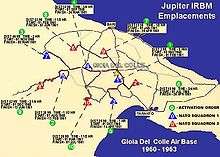
- Headquarters: Gioia del Colle Air Base, the launch sites (built in a triangular configuration) were in the direct vicinity of the villages Acquaviva delle Fonti, Altamura (two sites), Gioia del Colle, Gravina in Puglia, Laterza, Mottola, Spinazzola, Irsina and Matera.
- Training Pad 40°47′6.74″N 16°55′33.5″E / 40.7852056°N 16.925972°E
- Squadron 1
- Site 1 40°44′24.59″N 16°55′58.83″E / 40.7401639°N 16.9330083°E
- Site 3 40°35′42.00″N 16°51′33.00″E / 40.5950000°N 16.8591667°E
- Site 4 40°48′47.05″N 16°22′53.08″E / 40.8130694°N 16.3814111°E
- Site 5 40°45′32.75″N 16°22′53.08″E / 40.7590972°N 16.3814111°E
- Site 7 40°57′43.98″N 16°10′54.66″E / 40.9622167°N 16.1818500°E
- Squadron 2
- Site 2 40°40′42.00″N 17°6′12.03″E / 40.6783333°N 17.1033417°E
- Site 6 40°58′6.10″N 16°30′22.73″E / 40.9683611°N 16.5063139°E
- Site 8 40°42′14.98″N 16°8′28.42″E / 40.7041611°N 16.1412278°E
- Site 9 40°55′23.40″N 16°48′28.54″E / 40.9231667°N 16.8079278°E
- Site 10 40°34′59.77″N 16°35′43.26″E / 40.5832694°N 16.5953500°E
- Turkish Republic
- Headquarters: Cigli Air Base
- Training Pad 38°31′17.32″N 27°1′3.89″E / 38.5214778°N 27.0177472°E
- Site 1 38°42′26.68″N 26°53′4.13″E / 38.7074111°N 26.8844806°E
- Site 2 38°42′23.76″N 27°53′57.66″E / 38.7066000°N 27.8993500°E
- Site 3 38°50′37.66″N 27°02′55.58″E / 38.8437944°N 27.0487722°E
- Site 4 38°44′15.13″N 27°24′51.46″E / 38.7375361°N 27.4142944°E
- Site 5 38°47′30.73″N 27°42′28.94″E / 38.7918694°N 27.7080389°E
Description
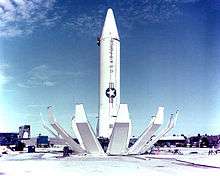

Jupiter squadrons consisted of 15 missiles and approximately 500 military personnel with five "flights" of three missiles each, manned by five officers and 10 NCOs. To reduce vulnerability, the flights were located approximately 30 miles apart, with the triple launcher emplacements separated by a distance of several hundred miles.
The ground equipment for each emplacement was housed in approximately 20 vehicles; including two generator trucks, a power distribution truck, short- and long-range theodolites, a hydraulic and pneumatic truck and a liquid oxygen truck. Another trailer carried 6000 gallons of fuel and three liquid oxygen trailers each carried 4,000 US gallons (15,000 l; 3,300 imp gal).
The missiles arrived at the emplacement on large trailers; while still on the trailer, the crew attached the hinged launch pedestal to the base of the missile which was hauled to an upright position using a winch. Once the missile was vertical, fuel and oxidizer lines were connected and the bottom third of the missile was encased in a "flower petal shelter", consisting of wedge-shaped metal panels, allowing crew members to service the missiles in all weather conditions. Stored empty, on 15-minute combat status in an upright position on the launch pad, the firing sequence included filling the fuel and oxidizer tanks with 68,000 lb (31,000 kg) of LOX and 30,000 lb (14,000 kg) of RP-1, while the guidance system was aligned and targeting information loaded. Once the fuel and oxidizer tanks were full, the launch controlling officer and two crewmen in a mobile launch control trailer could launch the missiles.
Each squadron was supported by a receipt, inspection and maintenance (RIM) area to the rear of the emplacements. RIM teams inspected new missiles and provided maintenance and repair to missiles in the field. Each RIM area also housed 25 tons of liquid oxygen and nitrogen generating plants. Several times a week, tanker trucks carried the fuel from the plant to the individual emplacements.
Specifications (Jupiter MRBM)
- Length: 60 ft (18.3 m)
- Diameter: 8 ft 9 in (2.67 m)
- Total Fueled Weight: 108,804 lb (49,353 kg)
- Empty Weight: 13,715 lb (6,221 kg)
- Oxygen (LOX) Weight: 68,760 lb (31,189 kg)
- RP-1 (kerosene) Weight: 30,415 lb (13,796 kg)
- Thrust: 150,000 lbf (667 kN)
- Engine: Rocketdyne LR70-NA (Model S-3D)
- ISP: 247.5 s (2.43 kN·s/kg)
- Burning time: 2 min. 37 sec.
- Propellant consumption rate: 627.7 lb/s (284.7 kg/s)
- Range: 1,500 mi (2,400 km)
- Flight time: 16 min 56.9 sec
- Cutoff velocity: 8,984 mph (14,458 km/h) – Mach 13.04
- Reentry velocity: 10,645 mph (17,131 km/h) – Mach 15.45
- Acceleration: 13.69 g (134 m/s²)
- Peak deceleration: 44.0 g (431 m/s²)
- Peak altitude: 390 mi (630 km)
- CEP 4,925 ft (1,500 m)
- Warhead: 1.45 Mt Thermonuclear W49 – 1,650 lb (750 kg)
- Fusing: Proximity and Impact
- Guidance: Inertial
Launch vehicle derivatives

The Saturn I and Saturn IB rockets were manufactured by using a single Jupiter propellant tank, in combination with eight Redstone rocket propellant tanks clustered around it, to form a powerful first stage launch vehicle.
The Jupiter MRBM was also modified by adding upper stages, in the form of clustered Sergeant-derived rockets, to create a space launch vehicle called Juno II, not to be confused with the Juno I which was a Redstone-Jupiter-C missile development. There is also some confusion with another U.S. Army rocket called the Jupiter-C, which were Redstone missiles modified by lengthening the fuel tanks and adding small solid-fueled upper stages.
Specifications (Juno II launch vehicle)

The Juno II was a four-stage rocket derived from the Jupiter IRBM. It was used for 10 satellite launches, six of which failed. It launched Pioneer 3, Pioneer 4, Explorer 7, Explorer 8, and Explorer 11.
- Juno II total length: 24.0 m
- Orbit payload to 200 km: 41 kg
- Escape velocity payload: 6 kg
- First launch date: December 6, 1958
- Last launch date: May 24, 1961
| Parameter | 1st stage | 2nd stage | 3rd stage | 4th stage |
|---|---|---|---|---|
| Gross mass | 54,431 kg | 462 kg | 126 kg | 42 kg |
| Empty mass | 5,443 kg | 231 kg | 63 kg | 21 kg |
| Thrust | 667 kN | 73 kN | 20 kN | 7 kN |
| Isp | 248 s (2.43 kN·s/kg) |
214 s (2.10 kN·s/kg) |
214 s (2.10 kN·s/kg) |
214 s (2.10 kN·s/kg) |
| Burn time | 182 s | 6 s | 6 s | 6 s |
| Length | 18.28 m | 1.0 m | 1.0 m | 1.0 m |
| Diameter | 2.67 m | 1.0 m | 0.50 m | 0.30 m |
| Engine: | Rocketdyne S-3D | Eleven Sergeants | Three Sergeants | One Sergeant |
| Propellant | LOX/RP-1 | Solid Fuel | Solid Fuel | Solid fuel |
Jupiter MRBM and Juno II launches
There were 46 test launches, all launched from Cape Canaveral Missile Annex, Florida.[43]
| Serial number | Mission | Launch date | Notes |
|---|---|---|---|
| AM-1A | AM-1A | March 1, 1957 | Test Launch 1. Missile test. Failure. Apogee 14 mi (23 km) |
| AM-1B | AM-1B | April 26, 1957 | Test Launch 2. Missile test. Failure. Apogee 18 mi (29 km) |
| AM-1 | AM-1 | May 31, 1957 | Test Launch 3. Missile test. Success. Apogee 500 mi (800 km) |
| AM-2 | AM-2 | August 28, 1957 | Test Launch 4. Missile test. Success. Apogee 500 mi (800 km) |
| AM-3 | AM-3 | October 23, 1957 | Test Launch 5. Missile test. Success. Apogee 500 mi (800 km) |
| AM-3A | AM-3A | November 27, 1957 | Test Launch 6. Missile test. Failure. Apogee 20 mi (32 km) |
| AM-4 | AM-4 | December 16, 1957 | Test Launch 7. Missile test. Failure. Apogee 63 mi (101 km) |
| AM-5 | AM-5 | May 18, 1958 | Test Launch 8. Reentry test. Success. Apogee 345 mi (555 km) |
| AM-6B | AM-6B | July 17, 1958 | Test Launch 9. Reentry test. Success. Apogee 345 mi (555 km) |
| AM-7 | AM-7 | August 27, 1958 | Test Launch 10. Missile test. Success. Apogee 345 mi (555 km) |
| AM-9 | AM-9 | October 10, 1958 | Test Launch 11. Missile test. Failure. Apogee 0 mi (0 km) |
| AM-11 | Juno II | December 6, 1958 | Launch 12. Lunar probe. Pioneer 3. Failed to reach moon. Apogee 70,610 mi (113,640 km) |
| AM-13 | Bio 1 | December 13, 1958 | Launch 13. Bio test flight. "Gordo" the monkey. Parachute failed. Apogee 345 mi (555 km) |
| CM-21 | CM-21 | January 22, 1959 | Test Launch 14. Tactical test flight. Success. Apogee 345 mi (555 km) |
| CM-22 | CM-22 | January 27, 1959 | Test Launch 15. Missile test. Success. Apogee 345 mi (555 km) |
| AM-14 | Juno II | March 3, 1959 | Launch 16. Lunar probe. Pioneer 4. Passed within 58,983 km (probably improperly converted as others were here, unless original was 36,650 mi) of moon. In solar orbit. |
| CM-22A | CM-22A | April 4, 1959 | Test Launch 17. Missile test. Success. Apogee 345 mi (555 km) |
Operators
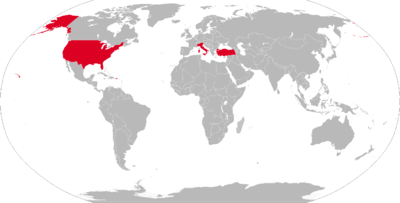
Former operators
- 36ª Brigata Aerea Interdizione Strategica (36th Strategic Air Interdiction Brigade)
Surviving examples

The Marshall Space Flight Center in Huntsville, Alabama displays a Jupiter missile in its Rocket Garden.
The U.S. Space & Rocket Center in Huntsville, Alabama displays two Jupiters, including one in Juno II configuration, in its Rocket Park.
An SM-78/PMG-19 is on display at the Air Force Space & Missile Museum at Cape Canaveral, Florida. The missile had been present in the rocket garden for many years until 2009 when it was taken down and given a complete restoration.[44] This pristine artifact is now in sequestered storage in Hangar R on Cape Canaveral AFS and cannot be viewed by the general public.
A Jupiter (in Juno II configuration) is displayed in the Rocket Garden at Kennedy Space Center, Florida. It was damaged by Hurricane Frances in 2004,[45] but was repaired and subsequently placed back on display.
A PGM-19 is on display at the National Museum of the United States Air Force in Dayton, Ohio. The missile was obtained from the Chrysler Corporation in 1963. For decades it was displayed outside the museum, before being removed in 1998. The missile was restored by the museum's staff and was returned to display in the museum's new Missile Silo Gallery in 2007.[46]
A PGM-19 is on display at the South Carolina State Fairgrounds in Columbia, South Carolina. The missile, named Columbia, was presented to the city in the early 1960s by the US Air Force. It was installed at the fairgrounds in 1969 at a cost of $10,000.[47]
Air Power Park in Hampton, Virginia displays an SM-78.
The Virginia Museum of Transportation in downtown Roanoke, Virginia displays a Jupiter PGM-19.
The Frontiers of Flight Museum at Dallas Love Field in Dallas, Texas, has a Jupiter missile on display outdoors.
See also
- List of United States Air Force missile squadrons
- List of missiles
- M-numbers
- Strategic Air Command
- Theatre ballistic missiles
Notes
- ↑ In 1949, a Rear Admiral described the Air Force's policy as "ruthless and barbaric... random mass slaughter of men, women and children... militarily unsound... morally wrong... contrary to our fundamental ideals.[19]
- ↑ The Army noted that an overwater approach to the UK meant that Thor had little warning at all.
References
Citations
- ↑ "A Jump Start In The Missile Race". Smithsonian Air and Space Museum.
- 1 2 3 4 Healy 1958, p. 1.
- 1 2 3 4 Kyle 2011, IRBM Battle.
- ↑ Kyle 2011, The Design.
- 1 2 3 4 5 Neufeld 1990, p. 121.
- ↑ Neufeld 1990, p. 144.
- ↑ Mackenzie 1993, p. 135.
- 1 2 3 Mackenzie 1993, p. 136.
- ↑ Mackenzie 1993, p. 137.
- ↑ Converse III, Elliot (2012). Rearming for the Cold War 1945 - 1960 (PDF). Government Printing Office. p. 527.
- ↑ Mackenzie 1993, p. 138.
- ↑ "Installation history, 1957". US Army Redstone Arsenal History.
- ↑ Mackenzie 1993, p. 139.
- 1 2 3 4 Mackenzie 1993, p. 131.
- ↑ Mackenzie 1993, p. 132.
- ↑ Mackenzie 1993, p. 129.
- ↑ Neufeld 1990, p. 142.
- 1 2 3 Mackenzie 1993, p. 127.
- ↑ Mackenzie 1993, p. 123.
- ↑ "Air Force Calls Army Unfit to Guard Nation". The New York Times. 21 May 1956. p. 1.
- ↑ Larsen, Douglas (1 August 1957). "New Battle Looms Over Army's Newest Missile". Sarasota Journal. p. 35. Retrieved 18 May 2013.
- ↑ Walker, Bernstein & Lang 2003, pp. 27-30, 37.
- ↑ "Nickerson Accuses Wilson Of 'Grave Errors' On Missiles". The News and Courier. 28 June 1957. p. B-14. Retrieved 18 May 2013.
- ↑ "The Nickerson Case". Time. 18 March 1957.
- ↑ "Army Weights Court-Martial Over Missiles". St. Petersburg Times. 25 February 1957. p. 1. Retrieved 18 May 2013.
- 1 2 3 4 Kyle 2011, Air Force Gains Control.
- ↑ Ley, Willy (November 1958). "How Secret was Sputnik No. 1?". Galaxy. pp. 48–50. Retrieved 13 June 2014.
- ↑ David, Leonard (4 October 2002). "Sputnik 1: The Satellite That Started It All". Space.com. Archived from the original on 16 February 2006. Retrieved 20 January 2007.
- 1 2 Bilstein 1996, p. 25.
- ↑ Bilstein 1996, pp. 32-33.
- ↑ Bilstein 1996, p. 34.
- ↑ Kyle 2011, Testing Jupiter, Propulsion.
- 1 2 3 Kyle 2011, Testing Jupiter, Jupiter A.
- 1 2 Kyle 2011, Testing Jupiter, Jupiter-C.
- ↑ Kyle 2011, Testing Jupiter, Static Test.
- ↑ Johnstone, Harry. "The Life and Times of Harry M. Johnstone". Engine History.
- ↑ Kyle 2011, The Cape.
- 1 2 3 4 5 6 Kyle 2011, Jupiter Takes Flight.
- ↑ Parsch, Andreas. "Jupiter". Encyclopedia Astronautica. Retrieved 26 April 2014.
- ↑ Wade, Mark. "Jupiter". Encyclopedia Astronautica.
- ↑ Lednicer, David (9 December 2010). "Intrusions, Overflights, Shootdowns and Defections During the Cold War and Thereafter". Aviation History Pages. Retrieved 16 January 2011.
- ↑ Wade, Mark. "Juno II". Encyclopedia Astronautica. Retrieved 16 January 2011.
- ↑ "Jupiter". Cape Canaveral, Florida: Air Force Space and Missile Museum. Retrieved 26 April 2014.
- ↑ "Hurricane Frances damage to Kennedy Space Center". collect SPACE. Retrieved 24 February 2012.
- ↑ "Factsheets : Chrysler SM-78/PGM-19A Jupiter". National Museum of the United States Air Force. Retrieved 26 April 2014.
- ↑ Rantin, Bertram (6 October 2010). "The 2010 SC State Fair is just a week away". The State. South Carolina. Archived from the original on 7 October 2010. Retrieved 26 April 2014.
Bibliography
- Bilstein, Roger (1996). "Stages to Saturn". NASA History Office.
- Healy, Roy (18 December 1958). Development of the Rocket Engine for the Jupiter Missile (PDF) (Technical report). Rocketdyne.
- Kyle, Ed (14 August 2011). "King of Gods: The Jupiter Missile Story". Space Launch Report.
- Mackenzie, Donald (1993). Inventing Accuracy, a Historical Sociology of Nuclear Missile Guidance. MIT Press.
- Neufeld, Jacob (1990). The development of ballistic missiles in the United States Air Force 1945-1960. DIANE Publishing. ISBN 9781428992993.
- Walker, James; Bernstein, Lewis; Lang, Sharon (2003). Seize the High Ground: The U. S. Army in Space and Missile Defense (PDF). Washington, D.C.: Center of Military History. ISBN 9780160723087. OCLC 57711369. Retrieved 13 May 2013.
External links
| Wikimedia Commons has media related to Jupiter (missile). |
- Jupiter IRBM History, U.S. Army – Redstone Arsenal
- Jupiter IRBM, Encyclopedia Astronautica
- The Jupiter Missiles of Turkey, G. L. Smith
- Detailed spherical panoramas inside the aft (engine) compartment
